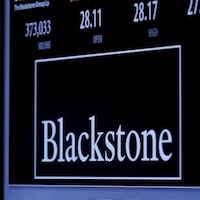News
Blackstone wants credit now for future Refinitiv cost cuts
Friday 7 September 2018

Blackstone thinks it can boost earnings at Thomson Reuters' terminals and data business by 35 per cent over three years after it buys a controlling interest.
It wants credit for those gains right now, Bloomberg quoted people with knowledge of the matter.
Blackstone is leading a consortium that’s putting together $13.5 billion of bond and loan financing to buy 55 per cent of the financial and risk division, which it will rebrand as Refinitive. The deal is set to close on 1 October.
They’re the largest junk debt offerings of the year, and to sell them the private equity firm is touting the cost savings it can wring from the unit, which will leave it with more cash to pay interest, the people told Bloomberg.
Without those savings, a measure of the company’s income known as earnings before interest, taxes, depreciation and amortisation (EBITDA) was around $1.88 billion for the 12 months ended 30 June. With the savings, that figure would be around $2.53 billion, according to the people, who asked not to be identified because they weren’t authorised to speak publicly about the matter.
“In today’s frothy credit markets, the Thomson Reuters unit is hardly alone in boosting a measure of its earnings as it tries to sell debt.,” Bloomberg reported.
Its 35 per cent adjustment is high by historical standards. In the beginning of 2015 the typical change for an acquisition was around 10 per cent, according to data from research firm Covenant Review.
The changes make a big difference in the potential riskiness of the deals, by at least one metric.
Using the company’s expectations, it will have debt equal to about 5.4 times EBITDA, below the six-times level that had raised regulators’ eyebrows starting in 2013. Without expected cost savings, debt will be equal to 7.3 times EBITDA. And using an estimate from S&P Global Ratings, indebtedness spikes to more than ten times that earnings figure.
At the heart of the different figures is the question of how much companies’ earnings can be adjusted when investors consider how much to lend. Corporations often use adjusted EBITDA figures in tests that determine whether they are healthy enough to continue borrowing.
Historically those tweaks factored out one-time events that might distort a metric of a company’s health, but over time the adjustments have grown more aggressive.
For acquisitions, EBITDA adjustments averaged closer to 35 per cent in the second quarter of this year, according to Covenant Review. ■
- SOURCE
- Bloomberg
- « Previous
- Next »
- 520 of 2174